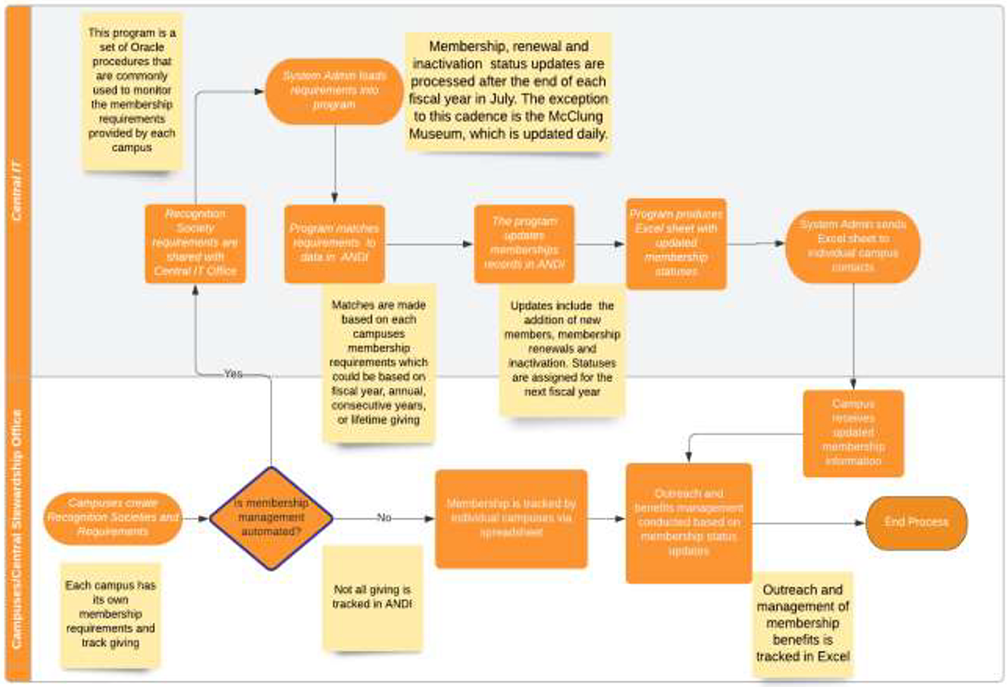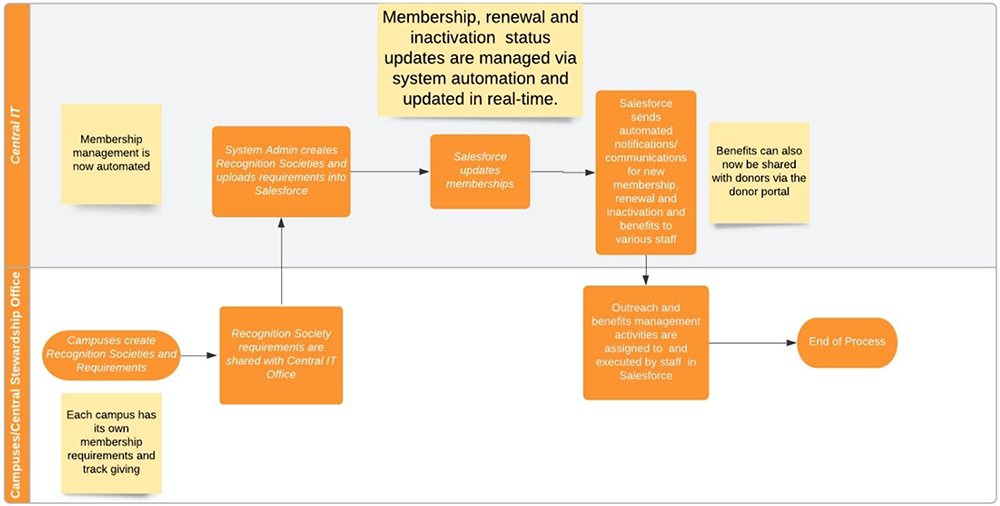Discovery Sessions
Process Overview
Recognition society membership is tracked at the campus level in the ANDI system or manually by colleges/departments. ANDI is used internally, with access shared by various staff members across campuses. The following three stakeholder types have been identified related to giving societies:
- Central IT Office (Internal)
- UT Campus Departments (Internal)
- Constituents (External)
For campuses/departments with recognition societies, each has its own requirements and track giving in one or multiple ways: consecutively, annually, or over a lifetime. The system administrators within the Central IT office have created a program in Oracle to update recognition society membership in ANDI based on the requirements provided by each campus. Updates to membership and renewal status only impact data that is tracked in ANDI, and the program processes information from ANDI once every fiscal year. Updates are shared to campuses via CSV-file sent from the Central IT office. Each campus then completes the appropriate outreach activities, including a welcome letter, updating donor walls, etc. There is currently no established communication plan for membership or a donor portal to drive engagement. In addition to campus recognition societies tracked in ANDI, many colleges and departments track recognition society membership external of the database, typically through the use of spreadsheets.

Opportunities
During discussion about the process, several improvement opportunities to address inefficiencies in the current state surfaced:
- Real-time Data Updates
- Membership updates occur only once per fiscal year
- Real-time updates would allow for more robust engagement activity planning (particularly with planning donor recognition events and updating the donor wall)
- Donors would see benefits of their society membership at an earlier stage
- Real-time data updates would meet constituent expectations (i.e., they expect to be treated as a member of a recognition society immediately upon making a donation)
- Data Centralization
- In the current state, not all recognition society data is tracked in ANDI; data not tracked in ANDI requires manual tracking on a spreadsheet
- Athletics has a separate tracking system for the Shareholders Society; it would be ideal to see membership for all recognition societies in one place
- Contact Reporting
- Contact reports and communication with constituents related to society membership (such as a welcome letter) are added to record manually; ideally thistype of communication would be batch loaded or automatically added
- Streamlined Reporting
- Currently, reporting on recognition society membership is a very manual process; stakeholders will benefit from more robust, streamlined reporting capabilities, especially as the university moves toward the campaign launch in 2025
- Targeting/Tracking
- Not all recognition societies are tracked on a donor’s ANDI record; tracking giving toward membership levels would allow for more targeted solicitations
- Real-time tracking would allow for enhanced constituent experience
- Communications
- The current system does not have a donor portal containing recognition society details; ideally, donors would have access to a portal through which they could view all their society memberships and associated benefits
- Better tracking/targeting presents opportunities to create/improve campaignsand communication plans
- Automation
- Some campuses and departments have not created recognition societies (i.e., UTIA)
- A more robust system to track giving programs and stewardship activities would increase the feasibility of establishing and managing recognition societies
Final Summary
The analysis shows that the current process possesses inefficiencies that increase the effort and time needed to track giving and membership in recognition societies. The infrequency with which data is updated hinders the ability to track membership in real time. Real-time tracking would allow for more frequent communication and engagement opportunities. The current state of tracking membership to recognition societies could benefit from the addition of centralizing all giving information, ensuring that donor records contain all giving data; reducing the number of systems used by different advancement entities; and improved contact reporting capability allowing for better communication, targeting activities and donor engagement.
Future State Process Overview
While recognition society membership is tracked in the ANDI system or manually by colleges/departments, the future of membership management will involve more robust automation. The stakeholders will remain the same:
- Central IT Office (Internal)
- UT Campus Departments (Internal)
For campuses/departments with recognition societies, the process of creating requirements will remain the same; each campus has its own requirements and track giving in one or multiple ways: consecutively, annually, or over a lifetime. The system administrators within the Central IT office will manage the creation of new societies and adding and maintaining the requirements of existing recognition societies into Salesforce. Updates to membership and renewal status will then be automated and tracked, in real-time, in Salesforce. Salesforce will send automated notifications/communications to various staff regarding donor’s membership status. Outreach and benefit management activities will be assigned to and executed by assigned staff and tracked in Salesforce.
Key Changes
During discussion about the process, several improvement opportunities to address inefficiencies in the current state surfaced:
- Real-time Data Updates
- Currently, membership status updates are processed once per fiscal year due to the manual nature of managing membership. b. In the future state, Membership updates will occur automatically and in nearly real time.
- Data Centralization
- In the current state, not all recognition society data is tracked in ANDI; data not tracked in ANDI requires manual tracking on a spreadsheet
- In the future state, all recognition society data will be tracked in Salesforce. In addition to membership status, additional information can be managed in ascend such as Membership Levels, Membership Benefits, Membership Beneficiaries, and Membership Stewardess.
- Contact Reporting
- In the current state, contact reports and communication with constituents related to society membership are added to records manually
- In the future, contact reports and communication with constituents related to society membership (such as a welcome letter) will be connected to constituent records.
- Streamlined Reporting
- Currently, reporting on recognition society membership is a very manual process
- In the future, reports can be easily built, maintained, and easily shared with staff.
- Targeting/Tracking
- Currently, not all recognition societies are tracked on a donor’s ANDI record
- In the future, all recognition society membership information will be available and tracked on a donor’s record.
- Constituent Portal
- Presently, the system does not have a donor portal containing recognition society details
- The future state will include a donor portal for donor engagement membershipmanagement.
- Automation
- Currently, some campuses and departments have not created recognition societies,
- The future state will provide new, efficient functionality will make it easier to do so. (i.e., UTIA)
- A more robust system to track giving programs and stewardship activities would increase the feasibility of establishing and managing recognition societies.
Considerations
- How will you onboard recognition societies to Salesforce that are not currently tracked in ANDI?
- How will you manage the future recognition society creation process?
- What society/membership information would you like your constituents to be able to view and manage in a future constituent portal?
Core Impact Summary
The future state of this process addresses challenges in the current state with respect to manual processes, data centralization, reporting and communication. Automation solves the problem of manually tracking membership via Excel spreadsheets. Centralizing all giving information will ensure that donor records contain all giving data. This change will reduce the number of systems used by different advancement entities and improve contact reporting capability allowing for better communication, targeting activities and donor engagement. Improved reporting capability will provide better tracking toward membership levels and the ability to easily and quickly share data with internal stakeholders. Additionally, as reporting and tracking capabilities are utilized, opportunities will expand to create and improve campaigns and communications plans.


